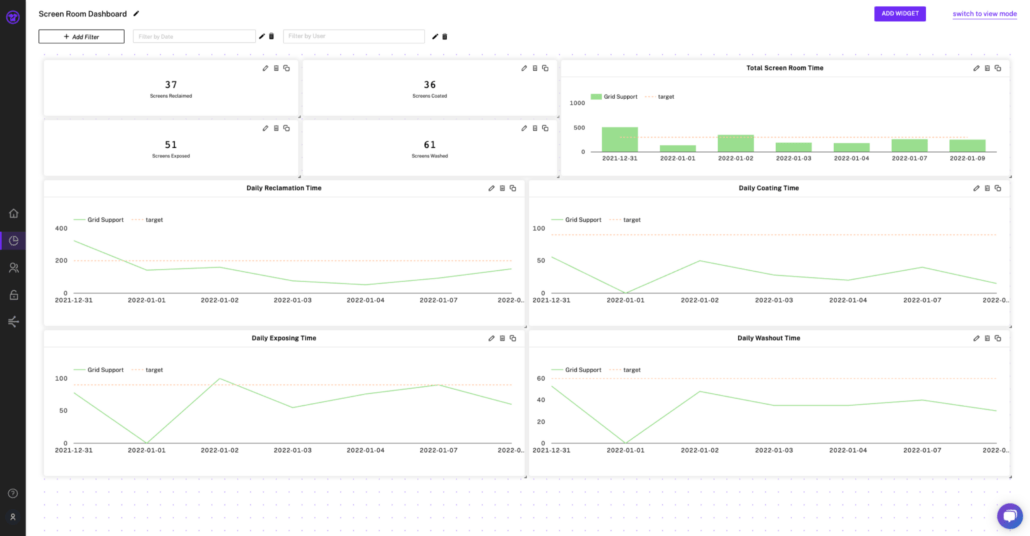How balanced is your shop with your processes? Are you on schedule? Do you have bottlenecks in your shop that you can’t locate? Sometimes this can be a hidden problem, so let’s shed some light on the subject.
For example, let’s talk about a fictional screenprint shop that is owned by Fred.
Fred’s shop has two automatic presses. One sneaky bottleneck that seems to constantly throw the production schedule off is that the print crew is always waiting on screens. It’s hard to keep up with production demands when you don’t have a positive workflow balance.
Theory of Constraints
Remember, the theory of constraints says that you can only move as fast as the slowest part of your process.

In Fred’s shop, they are using 91 screens a week between the two automatic presses. Lately, there has been a push to decrease the amount of downtime in the shop. Between conversations with the crew and looking at the data, it appears that a good chunk of the issues seem to stem from the screen room.

Here’s where the real trouble lies and it looks like it just going to get worse. The shop used 91 screens last week, but judging by the data collected by the screen room crew, the shop is out of balance with the demand.
Only 37 screens have been reclaimed. 36 screens have been coated. 51 screens were exposed. And 61 screens were washed out.
If you were Fred, what would you surmise about the screen room work load balance?
Yep. That is it out of whack.
Correcting the Balance
What needs to happen is that the workflow balance in the screen room should be reclaiming and coating about the same number that the shop is exposing and washing out. It is a supply and demand problem.
Fred’s shop is depleting the coated screens from their inventory faster than they are replenishing them.
Not to mention if they are using about 90 screens a week on average and only exposing 50, a good chunk of the downtime of the shop is spent waiting on screens to be ready so they can print.
It is apparent that there is a big problem, and it stems from actually not spending enough time doing the work. Like a lot of shops, there is a manpower shortage, and the person that handles the screen room work has been pulled out and redeployed to fill in. This solved one problem, but created another.
What is Eating Your Time?
In your shop, what is eating your time? Do you have the resources and the data to dig in and unravel the mystery of how to solve the problem?
By simply spending the effort in capturing data and then graphing it, you can unlock the answers. It is easier to see what is happening if you have a visualization of the shop’s performance in front of you.
Deep down in your gut, do you have something that is troubling you? I’d start measuring your data. Get those numbers up and onto a graph.
Only Three Things Will Happen
As my friend Mark Coudray always says, “There are only three things that are going to happen, and only one of them is good.”
- Things are going to improve.
- Things are going to stay the same.
- Things are going to get worse.
Measuring the performance of your team allows you to understand exactly what is happening. In a manufacturing environment, which our industry certainly participates, there has to be a balanced workflow.
Any bottleneck upsets that balance and somewhere down the road performance suffers. Costs increase. Deadlines are missed. Frustrations build.
Fingers start getting pointed. Not good.
But, there is a better way. One key to successful production management is obtaining accurate information and doing something with it. Something I’m constantly saying is that your “preparation determines your outcome.”
If you need workflow balance in your shop, start measuring. Get the data in front of you so that you can properly prepare and make better decisions.
“Almost all quality improvement comes via simplification of design, manufacturing…layout, processes, and procedures.” – Tom Peters
“Luck is a very thin wire between survival and disaster, and not many people can keep their balance on it.” – Hunter S. Thompson
“Efficiency is doing things right; effectiveness is doing the right things.” – Peter Drucker
Help Support This Blog

If you like this blog and would like to support it, you can:
- Buy a book.
- Share this blog on your social media.
- Join Shirt Lab Tribe.
- Subscribe to the Success Stories podcast.
- Watch and like an episode on the Jerzees Adventures in Apparel Decorating YouTube series.
- Get signed up for the new Production Tracker app.
Thanks!






